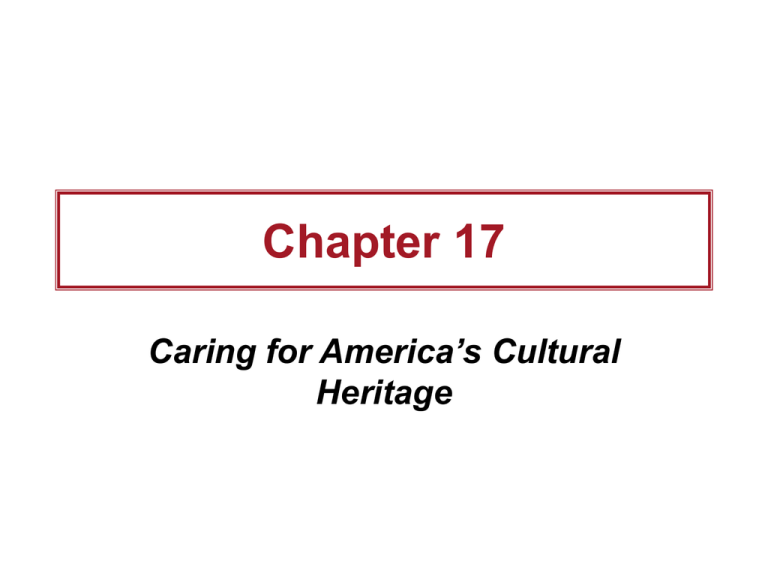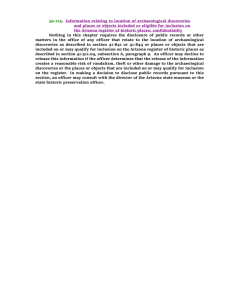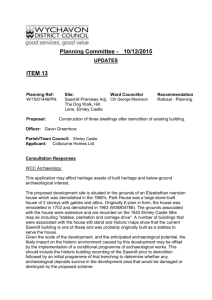Cultural Resource Management
advertisement

Chapter 17 Caring for America’s Cultural Heritage Outline • The Development of Cultural Resource Management • Historic Preservation Comes of Age • The National Historic Preservation Act • The Archaeological Resources Protection Act Outline • Challenges Facing CRM Archaeology • International Efforts to Protect Cultural Resources • The Native American Graves Protection and Repatriation Act of 1990 Cultural Resource Management • Threats to America’s cultural heritage come from those who loot archaeological sites and from relentless development across the country. • The federal government has passed laws to protect archaeological sites, historic buildings, and landscapes. • These laws have created an important new direction for archaeology, known as cultural resource management (CRM). Cultural Resource Management • Prior to the 1960s, nearly all American archaeologists worked for universities and museums. • Today, the number of archaeologists in the United States not only vastly exceeds those working in the 1960s, but well over half of them work in the framework of cultural resource management. • CRM projects account for about 90% of the field archaeology conducted today in United States. 1906 Antiquities Act • Although individual sites were protected through specific pieces of legislation or by the actions of concerned citizens, the first legislation to protect all sites on public lands was the 1906 Antiquities Act. 1966 National Historic Preservation Act (NHPA) • The first systematic effort to preserve cultural resources. • The act required the government to inventory historic structures and archaeological sites and ensure that development projects consider effects on archaeological sites. • The act established the National Register of Historic Places and State Historic Preservation Offices. 1979 Archaeological Resources Protection Act • This act provided further safeguards against the destruction of archaeological sites on federal and tribal land by increasing the penalties for excavating without a permit. • Looting still continues to be the major threat to the nation’s cultural resources. Rosetta Stone • A black basalt stone tablet found in 1799 that bears an inscription in two forms of ancient Greek and ancient Egyptian. • By working from the Greek texts, scholars were able to decipher the ancient Egyptian hieroglyphs. • Napoleon took the Rosetta Stone from Egypt as part of the spoils of war. Illegal Antiquities • The United States and many nations around the world are working to stop the flow of illegally acquired antiquities. • Although many measures have been put into place, most countries still find it difficult to stop antiquities from entering a country where buyers are willing to pay high prices for them. UNESCO Convention of 1970 • Requires that signers create legislation and the administration to: 1. Regulate import and export of cultural objects. 2. Forbid museums from acquiring illegally exported cultural objects. 3. Establish ways to inform other nations when illegally exported objects are found within a country’s borders. UNESCO Convention of 1970 4. Return of cultural objects stolen from public institutions. 5. Establish a register of art dealers and require them to register. 1990 Native American Graves Protection and Repatriation Act • Often seen as human rights rather than archaeological legislation. • Protects Indian graves on federal and tribal lands. • Recognizes tribal authority over treatment of unmarked graves. • Prohibits the commercial selling of native dead bodies. 1990 Native American Graves Protection and Repatriation Act • Requires an inventory and repatriation of human remains held by the federal government and institutions that receive federal funding. • Requires these institutions to return inappropriately acquired sacred objects and other important communally owned property to native owners. • Set up a process to determine ownership of human remains found on federal and tribal property after November 16, 1990. NAGPRA Inventories • Inventories showed that American institutions held more than 117,000 sets of human remains, • Most were from Native American burials. NAGPRA Inventories • The inventory covered skeletal remains as well as three special classes of objects: – Funerary objects placed with a human body as part of a death rite or ceremony or made to contain human remains at the time of burial. – Sacred objects necessary for current practice of traditional Native American religions. – Objects that have ongoing historical, traditional, or cultural importance central to Native American culture. Courses That Prepare You for a Career in Archaeology • Major in anthropology and take courses in biological, linguistic and cultural anthropology. • Courses in geology, biology, chemistry • Geomorphology • Advanced chemistry • Vertebrate anatomy • Ecology, paleoecology • Introductory business • Math - at least through calculus II • Statistics(multivariate statistics) • Computer modeling and geographic information systems • Technical or Creative writing • Humanities courses • Foreign language Quick Quiz 1. The biggest threats to America’s cultural heritage come from those who loot archaeological sites and from relentless development across the country. A. True B. False Answer: A. True • The biggest threats to America’s cultural heritage come from those who loot archaeological sites and from relentless development across the country. 2. _____ ______ _____ projects account for about 90% of the field archaeology conducted today in United States. Answer: Cultural Resource Management • Cultural Resource Management projects account for about 90% of the field archaeology conducted today in United States. 3. Which act requires an inventory and repatriation of human remains held by the federal government and institutions that receive federal funding: A. 1966 National Historic Preservation Act (NHPA) B. UNESCO Convention of 1970 C. 1979 Archaeological Resources Protection Act D. 1990 Native American Graves Protection and Repatriation Act Answer: D • The 1990 Native American Graves Protection and Repatriation Act requires an inventory and repatriation of human remains held by the federal government and institutions that receive federal funding.





